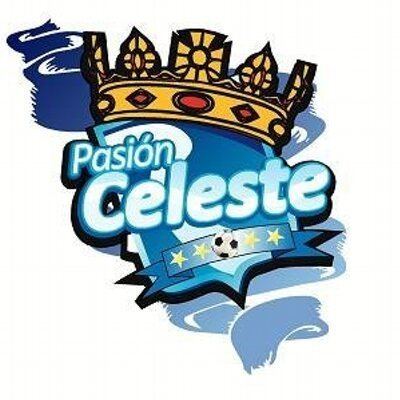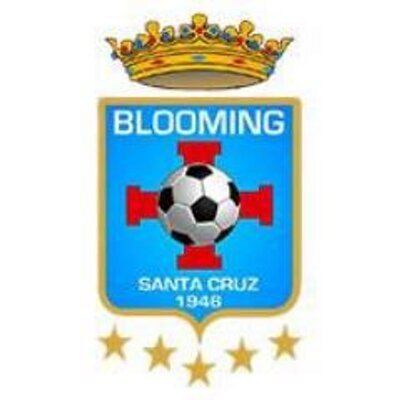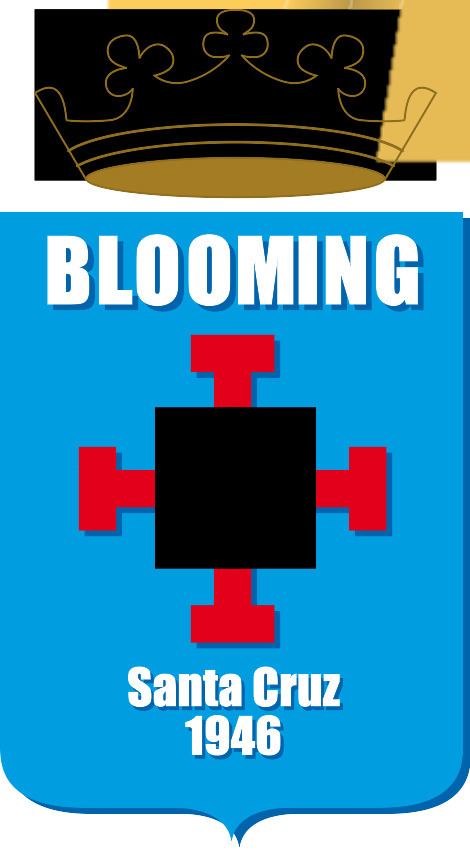Ground Capacity 38,000 Apertura 2015 8º | Chairman Jerjes Justiniano Founded 1 May 1946 | |
 | ||
Full name Club Social, Cultural y Deportivo Blooming Ground Estadio Tahuichi Aguilera,Santa Cruz, Bolivia League Liga de Fútbol Profesional Boliviano Location Santa Cruz de la Sierra, Bolivia | ||
Club Social, Cultural y Deportivo Blooming is a Bolivian football club from Santa Cruz de la Sierra, formed on May 1, 1946. Its home colours are sky blue, white and navy. They play at the Estadio Ramón Tahuichi Aguilera (38,000 seats). Its main rival is Oriente Petrolero, also from Santa Cruz. When they face each other in the local derby also known as "clásico cruceño", it is considered one of the most important matches in Bolivian football due to the fanaticism and passion of its fans, as well as, the expectation and interest it generates in the rest of the country.
Contents
- 1946 to 1970s
- 1980s
- 1990s
- 2000 to present day
- National Honors
- Performance in CONMEBOL competitions
- Current squad
- Notable former players
- Presidential history
- References

1946 to 1970s

On May 1, 1946 a group of young men led by Humberto Vaca Pereyra Montaño, agreed to establish a new football club after the rupture of a previous team they had put together called "Blue Sky". In their quest to find a name, they looked for inspiration in the city of Santa Cruz's flourishing youth; therefore, they decided to name the team officially as "Club Blooming". In the years following its foundation, Blooming became a very successful club in the amateur league winning several tournaments held in the region. By 1953, the board of directors determined that it was time to enhance the club's status.

Hence, Blooming made the transition from amateur to professional football after defeating two other local teams in a short tournament. From that moment, the team earned the right to be a member of the Asociación Cruceña de Fútbol (ACF), a regional association which happened to be the highest football entity in the Santa Cruz department during that time.

In 1977, the Liga de Fútbol Profesional Boliviano was born. The league comprised sixteen traditional clubs from all across the country, among them Blooming. At the time the club appointed a new chairman, his name was Roberto "Tito" Paz, a well-known and respected businessman from Santa Cruz who would transform the team into a true powerhouse in the following years. Blooming's first official match in the league was played on September 17, 1977 in a 3–1 victory over Real Santa Cruz.
1980s

After playing in first division for a few seasons, Blooming managed to solidify a team that became one of the finest in Bolivian football during the early 1980s.
The manager at that time was Chilean native Raúl "El Mago" Pino. Under his directions he had a group of talented players including Silvio Rojas, Juan Carlos Sánchez, Milton Melgar, Roly Paniagua, Rolando Coimbra and Miguel Ángel Noro among others. They all became great contributors in helping the club make history by finishing as runners-up in 1982 and 1983, and winning the first national championship in 1984; thanks to that glorious long range shot by Milton Melgar in injury time against Bolívar in Cochabamba.
Consequently, Blooming participated in the 1985 edition of Copa Libertadores against Venezuelan clubs Deportivo Táchira and Deportivo Italia, as well as Oriente Petrolero in Group B. That year Juan Carlos Sánchez wrote his name in the book of records of that prestigious tournament. During a home game against Deportivo Italia from Venezuela, which Blooming won by a crushing 8–0 he scored six goals alone, and set a personal record unlikely to be broken in Libertadores. The team had an impressive run and advanced to the semi-finals stage undefeated. However, the dream of winning the most desired trophy in the continent vanished after finishing last in a group series against Argentine clubs Independiente and Argentinos Juniors, the last one claiming the title that year. That was Blooming’s best performance in a CONMEBOL competition to date. The rest of the decade was a period characterized by regular seasons.
1990s
Entering this decade, Blooming regained that winning spirit that got lost towards the end of the 1980s. A new generation of players including Jaime Moreno, Juan Manuel Peña, and Berthy Suárez placed the club back among the elite in Bolivian football. In both seasons, 1990 and 1991, the team came close from winning the national championship by reaching semi-finals with Ramiro Blacut as the manager; nonetheless, the academia cruceña lost to Bolívar and San José respectively. In 1994 the team started the tournament strong. On January 19 of that year, Blooming defeated its biggest rival Oriente Petrolero by the largest margin in the derby's history.
It was an unforgettable victory by 5–0 with goals scored by Hebert Arandia (2), Jaime Moreno (2) and Juan Carlos Chávez. However, the game wasn't played in full length because Oriente's supporters couldn't take the embarrassment. They knocked down the fence and entered the field on the 75th minute causing disturbs. Fortunately, the local authorities intervened on time and the game got suspended. Subsequently, it was resumed two days later at closed door. After such a colossal victory, Blooming stayed motivated throughout the season obtaining good results and making the play-offs, but ultimately they finished with a bitter third place behind La Paz's clubs The Strongest and Bolívar, and missed another opportunity to take part in an international tournament.
During the second semester of 1994, Blooming began experiencing difficult times financially. The condition had severe implications in the players as they went on strike in several occasions. The evident lack of motivation was soon reflected on the field, as the team didn’t qualify to any of the two championship play-offs, and what is worse, it compromised its permanence in first division football due to a poor performance throughout the season. Entering 1995 the financial crisis exacerbated. Blooming no longer had the capacity to pay its players. Tired of this situation, most of them left the institution and signed for other teams. Clearly the club had no other alternative, but to turn to its youth sector as the last resort to compete in the local tournament. Despite the tremendous effort exhibited by these youngsters, the team finished second-bottom of the league having to play a relegation series with the Copa Simón Bolívar’s runners-up. On November of that year in La Paz, Blooming lost to Chaco Petrolero 6–5 on penalty kicks, after a 1–1 score during reglamentary time. Hence, the team was relegated for the first time since the league was founded in 1977.
The following year Blooming celebrated its 50th year anniversary playing in second division; however, a fresh board of directors with Juan Callaú in command, promised the supporters that the team would return to first division in 1997. The first step was to find a manager with a strong background, who was familiar with Bolivian football and had the willingness to undertake this pretentious project. That's how they determined to bring onboard Carlos Aragonés, a prominent manager who had won the national title with The Strongest a few years back. The club was also strengthened with great off-season acquisitions like young talented midfielder Limberg Gutiérrez, experienced striker Víctor Hugo Antelo, Tahuichi right-back Renny Ribera and other important players, which got on well with rest of the squad; forming a solid and consistent team that won the promotion in 1996 by defeating Club Universidad from Santa Cruz in the Copa Simón Bolívar finals.
With the imminent return of Blooming to first division football, the club once again occupied a seat of honor among the best teams in Bolivia. In 1997, la academia made a successful comeback; in the Apertura the club finished first in its group; nevertheless it fell short from winning the title by getting knocked-out in semi-finals by Bolívar. In the Clausura Blooming qualified as second best in its group, but in the "Hexagonal Final" the team lost terrain and ended up third behind Bolívar and Oriente; therefore, being left out of another Copa Libertadores berth. The following year and after leaving all the frustrations behind, Blooming resumed its protagonism in the league. With the basis of that group of players, along with the arrival of other key figures such as Bolivian internationals Rubén Tufiño and José Carlos Fernández, Blooming consolidated a squad that led the tournament from the beginning and culminated with the 1998 Clausura title. Later in the year they defeated Wistermann in the championship finals by scores of 3–0 at home and 1–0 as visitors.
The city of Santa Cruz turned into a carnival parade in mid December. The fans were exceedingly cheerful and euphoric to see their team win the first national championship in fourteen years. Luckily for them, the reason to celebrate a new championship didn't drag on. The following year, Blooming won the 1999 Apertura with seven points ahead of the second. Later, they faced the Clausura winners to determine the champions of 1999. Remarkably, Blooming dominated the series over The Strongest by a similar scores of 3–2 on both games, and retained the trophy for another year.
As an important fact, Blooming is the first team from Santa Cruz to win the title in consecutive seasons.
2000 to present day
In 2001, Blooming began renovating its squad since some of the talented players that took part in the back-to-back championship run left the institution. Nevertheless, this situation was compensated with the arrival of other young promising footballers, like striker Diego Cabrera. In the following years Blooming had modest participations in the league, maintaining a low profile and lacking ambition.
Finally in the 2005 Apertura, Blooming gave its fans a new reason to celebrate when they won the tournament with a young and rejuvenated team under the guidance of Gustavo Quinteros. Blooming secured the title on December 8, in the last game with a victory over The Strongest by 3–2 in La Paz. Thus, the team finished first in the final group stage or "final six" with five points ahead of Bolívar. Players such as Joselito Vaca, Gualberto Mojica, Lisandro Sacripanti and Pedro Higa were fundamental in enlighting the road towards the title.
The following year, the victorious path extended for Blooming as the team obtained the 2006 Copa Aerosur. After a prosperous run with Blooming, Quinteros left the club to manage a first division team in Argentina. His absence was deeply felt as the team experienced a football downfall shortly after his departure. Managers Abel Moralejo and later Álvaro Peña managed the club unsuccessfully during this period. In March 2007 Gustavo Quinteros returned to the institution to turn things around. There was an evident improvement and that team effort was rewarded with a spot in Copa Sudamericana the following year. Blooming began the 2008 season on a positive note. For the second time in its history the team won the Copa Aerosur. This was achieved in part due to an outstanding performance displayed by club legend Hernán Boyero, who finished as the topscorer in that short tournament with 8 goals; however, the team wasn't able to match the same success once the Apertura tournament commenced, and finished with a disappointing six place, despite having a competitive team including Anderson Gonzaga, the tournament's topscorer with 16.
When the Clausura kicked-off, the team showed a considerable improvement and built up its confidence again. As result, Blooming qualify to the championship play-offs as the number one seed in its group. In semi-finals the club faced La Paz, one of the most regular clubs in the league in recent years. In the first-leg, Blooming encountered a solid and fierce home team, and was defeated 1–2 in the always imposing and tough Estadio Hernando Siles. Nevertheless, the players got their revenge and humiliated La Paz by a 5–0 score in the rematch played in Santa Cruz, making their way to the finals. Subsequently, they faced Aurora for the 2008 Clausura title. Each team prevailed in their respective home games without a goal differential rule established, so in order to crown a new champion a third and decisive match was scheduled in Sucre. The game was played under harsh weather conditions, with the final score 2–2 during regulation time. Unfortunately for Blooming, the penalty kicks favored Aurora (4–2) and they had to settle as runners-up.
The 2009 Clausura marked the consecration of the fifth title in Blooming's history. After qualifying third in its group, Blooming was matched up with Real Potosí in quarter-finals. The celestes managed to eliminate its opponent after a 0–0 draw in their visit to Potosi (4,000 mts above sea level) and a crucial 1–0 victory at home. In semi-finals they faced their fierce and eternal rival Oriente Petrolero. In the first-leg match Blooming succumbed by a 2–3 score, but in the second game the team overcame adversity and won by 1–0 with an opportunistic finish by Damián Akerman. Since the knock-out stage was subject to the away goals rule, Blooming advanced to the finals. This time the team on the other end was Bolívar. The first match was a struggle for Blooming, but came victorious on its ground by a 1–0 score. In the second-leg match played in La Paz the team felt the pressure exerted by the locals on and off the field; however, Blooming gave the first thrust thanks to a brilliant goal netted by Roger Suárez. Ultimately, Bolívar tied the game but the score (1–1) remained untouched through the end of regulation time.
National Honors
Performance in CONMEBOL competitions
Current squad
As of 11 January 2017Note: Flags indicate national team as defined under FIFA eligibility rules. Players may hold more than one non-FIFA nationality.
Notable former players
See also Category:Club Blooming players.
Presidential history
Here is a complete list of Club Blooming presidents from 1946 to present day.
